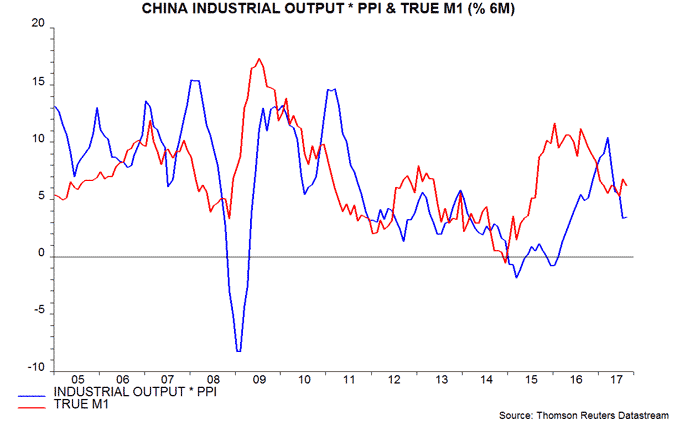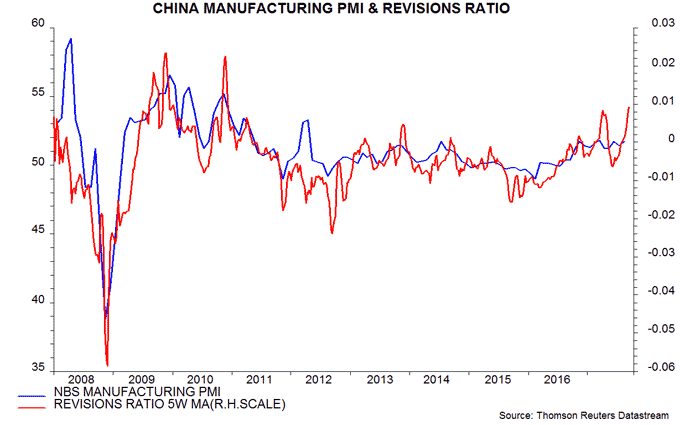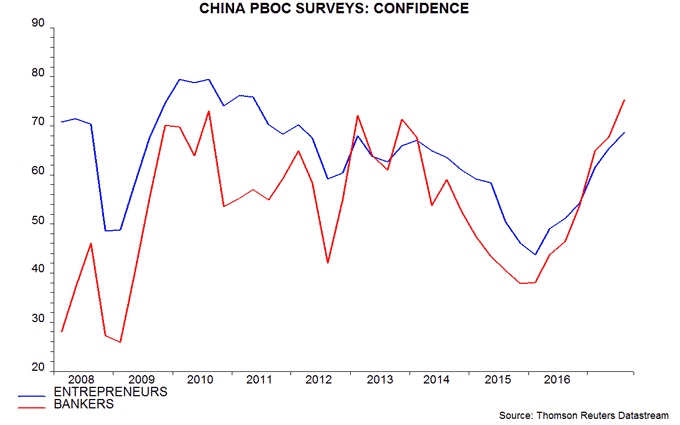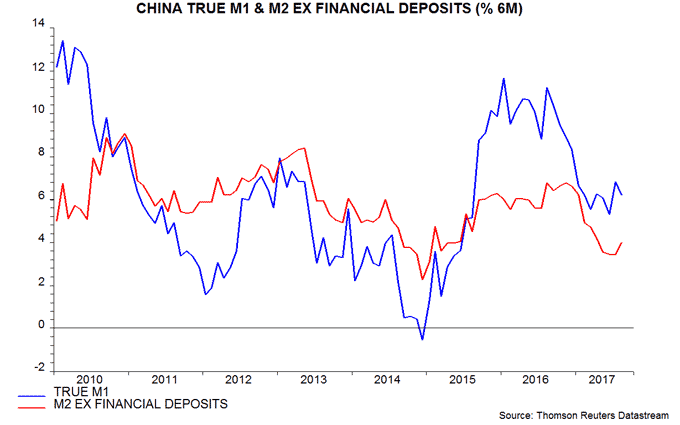Entries from September 10, 2017 - September 16, 2017
Chinese narrow money trends reassuring
Chinese narrow money continues to expand at a respectable pace, suggesting broadly stable economic growth and inflation through early 2018.
Six-month growth of the “true M1” measure tracked here fell significantly in late 2016 / early 2017 but has stabilised in recent months at about 6%, or 12% at an annualised rate. This is around the middle of the range in recent years and well above levels reached in 2014 ahead of significant economic weakness – see first chart.

The earlier monetary slowdown has been reflected in a moderation in growth of nominal GDP and nominal industrial output, the latter proxied by multiplying the volume of output by producer prices – first chart. With narrow money growth stable since the spring, nominal output growth is unlikely to fall much further and may recover into early 2018.
Six-month growth of the volume of industrial output fell further in August but this may reflect supply-side influences – adverse weather and anti-pollution restrictions – rather than demand weakness. Consistent with this explanation, six-month producer price inflation ticked up, with a significant jump in prices in August alone – second chart.

The suggestion that nominal economic growth is holding up is supported by earnings trends, with the equity analysts’ revisions ratio moving back into positive territory recently – third chart. The PBoC’s third-quarter surveys of entrepreneurs and bankers, meanwhile, were upbeat, reporting further rises in confidence levels and profitability assessments – fourth chart.


Broad money is lagging narrow money: six-month growth of M2 excluding financial sector deposits, the preferred broad measure here, is near the bottom of its range in recent years, though ticked up in August – fifth chart. The higher level of narrow money growth, however, indicates that broad money weakness is not (yet) negatively affecting spending plans, probably because the improved economic climate has resulted in a decline in the demand to hold precautionary money balances.

UK MPC on course for November rate hike
Today’s communications suggest that the UK MPC will hike Bank rate to 0.5% on its next decision date of 2 November barring downside data surprises or market turbulence.
According to the minutes, a majority of members judged that, if the economy remains on the expected path, “some withdrawal of monetary stimulus was likely to be appropriate over the coming months”.
The unreliability of previous forward guidance increases the pressure on the Committee to follow through on this signal at the earliest opportunity.
The hawkish shift has been driven by recent data indicating stronger-than-expected activity and inflationary pressures – see previous post.
Key data inputs to the November decision will be September consumer price inflation and the preliminary estimate of third-quarter GDP growth, scheduled for release on 17 and 25 October respectively. The judgement here is that inflation would need to fall back to 2.7% or below and growth to undershoot the Bank of England staff’s 0.3% projection to head off a hike.
Major national accounts revisions due to be released on 29 September may also play into the MPC’s decision. The Office for National Statistics has already indicated that growth of household income and the level of the saving ratio over 2010-15 were higher than previously reported – see previous post. A similar upgrade to 2016-17 data could allay some MPC members’ concerns about the impact of a rate hike on consumer spending.
UK data arguing for early rate rise
UK consumer price inflation rebounded to 2.9% (2.86% before rounding) in August and is on course to exceed the August Inflation Report projections of 2.68% and 2.75% for the third and fourth quarters respectively. With activity data and surveys indicating that GDP growth is holding up in the third quarter, and the labour market tightening further, the case for reversing the August 2016 Bank rate cut has strengthened.
A post in July argued that a pull-back in CPI inflation from 2.9% in May to 2.6% in June represented temporary relief and that both headline and core rates would reach higher levels later in 2017. While August headline inflation was on a par with May, the core rate – i.e. excluding energy, food, alcohol and tobacco – moved up to 2.7% (2.66% before rounding). Core inflation is the highest since 2011, or 2009 excluding the impact of VAT changes.
The August increase partly reflected a sharp rise in annual clothing inflation, which may partially reverse in September – prices rose relatively strongly in September 2016. The contribution of electricity and gas prices, however, will increase, with British Gas raising its standard electricity tariff by 12.5% on 15 September. A surprise fall in food inflation, meanwhile, may be reversed: CPI food inflation of 2.3% in August is unusually low relative to producer output price inflation for food products of 5.9%. A rise in the maximum undergraduate tuition fee to £9,250 may exert a small upward influence from October.
The expectation here is that headline inflation will average 2.9% over the remainder of 2017, with a 3.0% reading likely in at least one month.
Output and turnover data released last week suggest that July GDP was 0.3% above the second quarter level, i.e. third-quarter growth is on track to match or exceed the 0.3% projection in the August Inflation Report. The single-month unemployment rate fell to 4.2% in June, below the Report's 4.4% forecast for the second half. Staff placements are rising strongly while candidate availability has declined further and starting salaries for permanent jobs are increasing at their fastest rate since 2015, according to the latest Recruitment and Employment Confederation survey.

